[English] 日本語
 Yorodumi
Yorodumi- PDB-1uom: The Structure of Estrogen Receptor in Complex with a Selective an... -
+ Open data
Open data
- Basic information
Basic information
| Entry | Database: PDB / ID: 1uom | ||||||
|---|---|---|---|---|---|---|---|
| Title | The Structure of Estrogen Receptor in Complex with a Selective and Potent Tetrahydroisochiolin Ligand. | ||||||
 Components Components | ESTROGEN RECEPTOR | ||||||
 Keywords Keywords |  NUCLEAR PROTEIN / SELECTIVE ESTROGEN RECEPTOR MODULATORS / SERM / NUCLEAR PROTEIN / SELECTIVE ESTROGEN RECEPTOR MODULATORS / SERM /  RECEPTOR / RECEPTOR /  TRANSCRIPTION REGULATION / DNA-BINDING / TRANSCRIPTION REGULATION / DNA-BINDING /  ZINC-FINGER / STEROID-BINDING / ZINC-FINGER / STEROID-BINDING /  PHOSPHORYLATION / POLYMORPHISM 3D-STRUCTURE / PHOSPHORYLATION / POLYMORPHISM 3D-STRUCTURE /  ALTERNATIVE SPLICING ALTERNATIVE SPLICING | ||||||
| Function / homology |  Function and homology information Function and homology informationregulation of epithelial cell apoptotic process / antral ovarian follicle growth / G protein-coupled estrogen receptor activity / regulation of branching involved in prostate gland morphogenesis / RUNX1 regulates transcription of genes involved in WNT signaling / RUNX1 regulates estrogen receptor mediated transcription /  regulation of toll-like receptor signaling pathway / prostate epithelial cord arborization involved in prostate glandular acinus morphogenesis / nuclear estrogen receptor activity / epithelial cell proliferation involved in mammary gland duct elongation ...regulation of epithelial cell apoptotic process / antral ovarian follicle growth / G protein-coupled estrogen receptor activity / regulation of branching involved in prostate gland morphogenesis / RUNX1 regulates transcription of genes involved in WNT signaling / RUNX1 regulates estrogen receptor mediated transcription / regulation of toll-like receptor signaling pathway / prostate epithelial cord arborization involved in prostate glandular acinus morphogenesis / nuclear estrogen receptor activity / epithelial cell proliferation involved in mammary gland duct elongation ...regulation of epithelial cell apoptotic process / antral ovarian follicle growth / G protein-coupled estrogen receptor activity / regulation of branching involved in prostate gland morphogenesis / RUNX1 regulates transcription of genes involved in WNT signaling / RUNX1 regulates estrogen receptor mediated transcription /  regulation of toll-like receptor signaling pathway / prostate epithelial cord arborization involved in prostate glandular acinus morphogenesis / nuclear estrogen receptor activity / epithelial cell proliferation involved in mammary gland duct elongation / epithelial cell development / prostate epithelial cord elongation / negative regulation of smooth muscle cell apoptotic process / mammary gland branching involved in pregnancy / uterus development / vagina development / TFIIB-class transcription factor binding / androgen metabolic process / steroid hormone mediated signaling pathway / mammary gland alveolus development / intracellular estrogen receptor signaling pathway / cellular response to estrogen stimulus / regulation of toll-like receptor signaling pathway / prostate epithelial cord arborization involved in prostate glandular acinus morphogenesis / nuclear estrogen receptor activity / epithelial cell proliferation involved in mammary gland duct elongation / epithelial cell development / prostate epithelial cord elongation / negative regulation of smooth muscle cell apoptotic process / mammary gland branching involved in pregnancy / uterus development / vagina development / TFIIB-class transcription factor binding / androgen metabolic process / steroid hormone mediated signaling pathway / mammary gland alveolus development / intracellular estrogen receptor signaling pathway / cellular response to estrogen stimulus /  estrogen response element binding / estrogen response element binding /  : / intracellular steroid hormone receptor signaling pathway / negative regulation of canonical NF-kappaB signal transduction / Nuclear signaling by ERBB4 / RNA polymerase II preinitiation complex assembly / protein localization to chromatin / 14-3-3 protein binding / TBP-class protein binding / : / intracellular steroid hormone receptor signaling pathway / negative regulation of canonical NF-kappaB signal transduction / Nuclear signaling by ERBB4 / RNA polymerase II preinitiation complex assembly / protein localization to chromatin / 14-3-3 protein binding / TBP-class protein binding /  steroid binding / nitric-oxide synthase regulator activity / TFAP2 (AP-2) family regulates transcription of growth factors and their receptors / ESR-mediated signaling / transcription corepressor binding / negative regulation of miRNA transcription / cellular response to estradiol stimulus / steroid binding / nitric-oxide synthase regulator activity / TFAP2 (AP-2) family regulates transcription of growth factors and their receptors / ESR-mediated signaling / transcription corepressor binding / negative regulation of miRNA transcription / cellular response to estradiol stimulus /  transcription coregulator binding / transcription coregulator binding /  stem cell differentiation / nuclear estrogen receptor binding / positive regulation of nitric-oxide synthase activity / SUMOylation of intracellular receptors / stem cell differentiation / nuclear estrogen receptor binding / positive regulation of nitric-oxide synthase activity / SUMOylation of intracellular receptors /  euchromatin / negative regulation of DNA-binding transcription factor activity / euchromatin / negative regulation of DNA-binding transcription factor activity /  beta-catenin binding / beta-catenin binding /  transcription coactivator binding / positive regulation of DNA-binding transcription factor activity / Nuclear Receptor transcription pathway / response to estrogen / Regulation of RUNX2 expression and activity / Constitutive Signaling by Aberrant PI3K in Cancer / transcription coactivator binding / positive regulation of DNA-binding transcription factor activity / Nuclear Receptor transcription pathway / response to estrogen / Regulation of RUNX2 expression and activity / Constitutive Signaling by Aberrant PI3K in Cancer /  nuclear receptor activity / positive regulation of nitric oxide biosynthetic process / male gonad development / positive regulation of fibroblast proliferation / sequence-specific double-stranded DNA binding / Ovarian tumor domain proteases / PIP3 activates AKT signaling / response to estradiol / phospholipase C-activating G protein-coupled receptor signaling pathway / nuclear receptor activity / positive regulation of nitric oxide biosynthetic process / male gonad development / positive regulation of fibroblast proliferation / sequence-specific double-stranded DNA binding / Ovarian tumor domain proteases / PIP3 activates AKT signaling / response to estradiol / phospholipase C-activating G protein-coupled receptor signaling pathway /  ATPase binding / positive regulation of cytosolic calcium ion concentration / ATPase binding / positive regulation of cytosolic calcium ion concentration /  regulation of inflammatory response / fibroblast proliferation / PI5P, PP2A and IER3 Regulate PI3K/AKT Signaling / DNA-binding transcription activator activity, RNA polymerase II-specific / Estrogen-dependent gene expression / regulation of inflammatory response / fibroblast proliferation / PI5P, PP2A and IER3 Regulate PI3K/AKT Signaling / DNA-binding transcription activator activity, RNA polymerase II-specific / Estrogen-dependent gene expression /  transcription regulator complex / Extra-nuclear estrogen signaling / transcription regulator complex / Extra-nuclear estrogen signaling /  calmodulin binding / DNA-binding transcription factor activity, RNA polymerase II-specific / calmodulin binding / DNA-binding transcription factor activity, RNA polymerase II-specific /  chromatin remodeling / RNA polymerase II cis-regulatory region sequence-specific DNA binding / DNA-binding transcription factor activity / negative regulation of gene expression / chromatin remodeling / RNA polymerase II cis-regulatory region sequence-specific DNA binding / DNA-binding transcription factor activity / negative regulation of gene expression /  chromatin binding / chromatin binding /  chromatin / regulation of DNA-templated transcription / regulation of transcription by RNA polymerase II / chromatin / regulation of DNA-templated transcription / regulation of transcription by RNA polymerase II /  protein kinase binding / positive regulation of DNA-templated transcription / protein kinase binding / positive regulation of DNA-templated transcription /  Golgi apparatus / Golgi apparatus /  enzyme binding / negative regulation of transcription by RNA polymerase II / enzyme binding / negative regulation of transcription by RNA polymerase II /  signal transduction / positive regulation of transcription by RNA polymerase II / protein-containing complex / zinc ion binding / signal transduction / positive regulation of transcription by RNA polymerase II / protein-containing complex / zinc ion binding /  nucleoplasm / nucleoplasm /  membrane / identical protein binding / membrane / identical protein binding /  nucleus / nucleus /  plasma membrane / plasma membrane /  cytosol / cytosol /  cytoplasm cytoplasmSimilarity search - Function | ||||||
| Biological species |   HOMO SAPIENS (human) HOMO SAPIENS (human) | ||||||
| Method |  X-RAY DIFFRACTION / X-RAY DIFFRACTION /  SYNCHROTRON / SYNCHROTRON /  MOLECULAR REPLACEMENT / Resolution: 2.28 Å MOLECULAR REPLACEMENT / Resolution: 2.28 Å | ||||||
 Authors Authors | Stark, W. / Bischoff, S.F. / Buhl, T. / Fournier, B. / Halleux, C. / Kallen, J. / Keller, H. / Renaud, J. | ||||||
 Citation Citation |  Journal: J.Med.Chem. / Year: 2003 Journal: J.Med.Chem. / Year: 2003Title: Estrogen Receptor Modulators: Identification and Structure-Activity Relationships of Potent Eralpha-Selective Tetrahydroisoquinoline Ligands Authors: Renaud, J. / Bischoff, S.F. / Buhl, T. / Floersheim, P. / Fournier, B. / Halleux, C. / Kallen, J. / Keller, H. / Schlaeppi, J.-M. / Stark, W. | ||||||
| History |
|
- Structure visualization
Structure visualization
| Structure viewer | Molecule:  Molmil Molmil Jmol/JSmol Jmol/JSmol |
|---|
- Downloads & links
Downloads & links
- Download
Download
| PDBx/mmCIF format |  1uom.cif.gz 1uom.cif.gz | 64 KB | Display |  PDBx/mmCIF format PDBx/mmCIF format |
|---|---|---|---|---|
| PDB format |  pdb1uom.ent.gz pdb1uom.ent.gz | 46.4 KB | Display |  PDB format PDB format |
| PDBx/mmJSON format |  1uom.json.gz 1uom.json.gz | Tree view |  PDBx/mmJSON format PDBx/mmJSON format | |
| Others |  Other downloads Other downloads |
-Validation report
| Arichive directory |  https://data.pdbj.org/pub/pdb/validation_reports/uo/1uom https://data.pdbj.org/pub/pdb/validation_reports/uo/1uom ftp://data.pdbj.org/pub/pdb/validation_reports/uo/1uom ftp://data.pdbj.org/pub/pdb/validation_reports/uo/1uom | HTTPS FTP |
|---|
-Related structure data
| Related structure data |  3ertS S: Starting model for refinement |
|---|---|
| Similar structure data |
- Links
Links
- Assembly
Assembly
| Deposited unit | 
| ||||||||
|---|---|---|---|---|---|---|---|---|---|
| 1 | 
| ||||||||
| Unit cell |
|
- Components
Components
| #1: Protein |  / ESTROGEN RECEPTOR ALPHA / ER / ESTRADIOL RECEPTOR / ER-ALPHA / ESR1 / NR3A1 / ESR / ESTROGEN RECEPTOR ALPHA / ER / ESTRADIOL RECEPTOR / ER-ALPHA / ESR1 / NR3A1 / ESRMass: 28972.021 Da / Num. of mol.: 1 / Fragment: LIGAND BINDING DOMAIN, RESIDUES 301 - 553 / Mutation: YES Source method: isolated from a genetically manipulated source Details: NVP-ADD562 L SOLVENT S / Source: (gene. exp.)   HOMO SAPIENS (human) / Plasmid: PET26B / Production host: HOMO SAPIENS (human) / Plasmid: PET26B / Production host:   ESCHERICHIA COLI (E. coli) / Strain (production host): BL21(DE3) / References: UniProt: P03372 ESCHERICHIA COLI (E. coli) / Strain (production host): BL21(DE3) / References: UniProt: P03372 |
|---|---|
| #2: Chemical | ChemComp-PTI / |
| #3: Water | ChemComp-HOH /  Water Water |
| Compound details | FUNCTION: NUCLEAR HORMONE RECEPTOR. THE STEROID HORMONES AND RECEPTORS AFFECT CELLULAR ...FUNCTION: NUCLEAR HORMONE RECEPTOR. THE STEROID HORMONES AND RECEPTORS AFFECT CELLULAR PROLIFERAT |
-Experimental details
-Experiment
| Experiment | Method:  X-RAY DIFFRACTION / Number of used crystals: 1 X-RAY DIFFRACTION / Number of used crystals: 1 |
|---|
- Sample preparation
Sample preparation
| Crystal | Density Matthews: 2.3 Å3/Da / Density % sol: 43 % | |||||||||||||||||||||||||||||||||||||||||||||||||||||||||||||||
|---|---|---|---|---|---|---|---|---|---|---|---|---|---|---|---|---|---|---|---|---|---|---|---|---|---|---|---|---|---|---|---|---|---|---|---|---|---|---|---|---|---|---|---|---|---|---|---|---|---|---|---|---|---|---|---|---|---|---|---|---|---|---|---|---|
Crystal grow | pH: 6.5 / Details: 0.1 M MES PH 6.5 9-11% PEG-3350, 0.4 M NACL | |||||||||||||||||||||||||||||||||||||||||||||||||||||||||||||||
| Crystal grow | *PLUS pH: 8 / Method: vapor diffusion, hanging drop | |||||||||||||||||||||||||||||||||||||||||||||||||||||||||||||||
| Components of the solutions | *PLUS
|
-Data collection
| Diffraction | Mean temperature: 100 K |
|---|---|
| Diffraction source | Source:  SYNCHROTRON / Site: SYNCHROTRON / Site:  ESRF ESRF  / Beamline: BM1A / Wavelength: 0.80034 / Beamline: BM1A / Wavelength: 0.80034 |
| Detector | Type: MARRESEARCH / Detector: IMAGE PLATE / Date: Jan 25, 2001 |
| Radiation | Protocol: SINGLE WAVELENGTH / Monochromatic (M) / Laue (L): M / Scattering type: x-ray |
| Radiation wavelength | Wavelength : 0.80034 Å / Relative weight: 1 : 0.80034 Å / Relative weight: 1 |
| Reflection | Resolution: 2.28→10 Å / Num. obs: 10439 / % possible obs: 77.8 % / Redundancy: 5.5 % / Biso Wilson estimate: 32.9 Å2 / Rmerge(I) obs: 0.053 / Net I/σ(I): 17.5 |
| Reflection shell | Resolution: 2.28→2.32 Å / Redundancy: 17.5 % / Rmerge(I) obs: 0.23 / Mean I/σ(I) obs: 10.7 / % possible all: 68.8 |
| Reflection | *PLUS Highest resolution: 2.28 Å / Rmerge(I) obs: 0.053 |
- Processing
Processing
| Software |
| ||||||||||||||||||||||||||||||||||||||||||||||||||||||||||||||||||||||||||||||||
|---|---|---|---|---|---|---|---|---|---|---|---|---|---|---|---|---|---|---|---|---|---|---|---|---|---|---|---|---|---|---|---|---|---|---|---|---|---|---|---|---|---|---|---|---|---|---|---|---|---|---|---|---|---|---|---|---|---|---|---|---|---|---|---|---|---|---|---|---|---|---|---|---|---|---|---|---|---|---|---|---|---|
| Refinement | Method to determine structure : :  MOLECULAR REPLACEMENT MOLECULAR REPLACEMENTStarting model: PDB ENTRY 3ERT Resolution: 2.28→9.99 Å / Rfactor Rfree error: 0.009 / Cross valid method: THROUGHOUT / σ(F): 0
| ||||||||||||||||||||||||||||||||||||||||||||||||||||||||||||||||||||||||||||||||
| Solvent computation | Solvent model: FLAT MODEL / Bsol: 46.02 Å2 / ksol: 0.377 e/Å3 | ||||||||||||||||||||||||||||||||||||||||||||||||||||||||||||||||||||||||||||||||
| Displacement parameters | Biso mean: 40.2 Å2
| ||||||||||||||||||||||||||||||||||||||||||||||||||||||||||||||||||||||||||||||||
| Refine analyze |
| ||||||||||||||||||||||||||||||||||||||||||||||||||||||||||||||||||||||||||||||||
| Refinement step | Cycle: LAST / Resolution: 2.28→9.99 Å
| ||||||||||||||||||||||||||||||||||||||||||||||||||||||||||||||||||||||||||||||||
| Refine LS restraints |
| ||||||||||||||||||||||||||||||||||||||||||||||||||||||||||||||||||||||||||||||||
| LS refinement shell | Resolution: 2.28→2.42 Å / Rfactor Rfree error: 0.029 / Total num. of bins used: 6
| ||||||||||||||||||||||||||||||||||||||||||||||||||||||||||||||||||||||||||||||||
| Xplor file |
| ||||||||||||||||||||||||||||||||||||||||||||||||||||||||||||||||||||||||||||||||
| Refinement | *PLUS Rfactor Rwork : 0.233 : 0.233 | ||||||||||||||||||||||||||||||||||||||||||||||||||||||||||||||||||||||||||||||||
| Solvent computation | *PLUS | ||||||||||||||||||||||||||||||||||||||||||||||||||||||||||||||||||||||||||||||||
| Displacement parameters | *PLUS | ||||||||||||||||||||||||||||||||||||||||||||||||||||||||||||||||||||||||||||||||
| Refine LS restraints | *PLUS
|
 Movie
Movie Controller
Controller


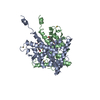

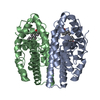

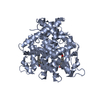

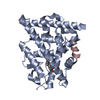


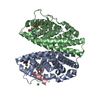
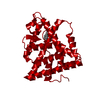
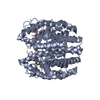
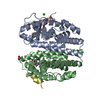






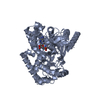

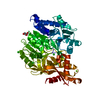

 PDBj
PDBj







